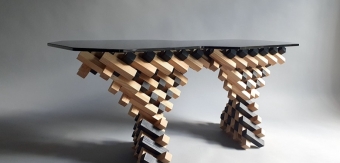A guide to freelance illustration rates, with tips and advice from experienced professionals in the industry
Illustrators are the makers of dreams. By combining art, design and creative skills, illustrators work to produce original images for a wide range of products and clients. But because most of them work freelance or in a self-employed fashion, it is quite normal for those just starting out to be wondering about freelance rates. How do you work out illustration rates for your clients and projects?
Not being an illustrator myself, I thought I could get in touch with someone who knew a tad more than I did. For this piece, I reached out to three of our top illustrators on Creativepool: Feifei Ruan, Javier Medellin Puyou (Jilipollo) and Martin Reznik.
If you are considering becoming a freelance illustrator, make sure to check out our illustrator job description article first!

Artwork credit: Martin Reznik
How do I charge for an illustration project?
Illustrators can work on a bunch of different projects, sometimes even for the same client. From book cover illustration to packaging and commercial work, freelance illustrators are far from a one-trick pony and they are certainly masters of many trades. For this reason, charges and rates for illustration work may vary enormously.
Feifei, for example, who specialises in commercial and book cover illustrations, said there is no standard rate when it comes to illustration work. Different jobs require different rates, but it can help to imagine the project as a full-time job and estimate what a monthly salary would be. For example, “if it looks like a $7,500/mo job, then my day rate would be around $350; If it looks like a $10k, then the day rate would be around $470.”
In any case, Feifei believes that you should start low, then work your way up – though in no case you should undercharge or work for free. We’ll get to that and the reasons in a later section below. Seeing “where you are” in terms of experience can help you find an appropriate rate for the current project.
Both Jilipollo and Martin, on the other hand, prefer to charge on a per-project basis. Jilipollo works constantly to keep his quality of work at the highest standard possible, so that he can keep charging fair prices. Martin, too, has an extremely laborious drawing style, and he feels like charging per hour would make the rates close to inhuman.
If you have a very laborious drawing style, charging per hour will make your rates inhuman
“This doesn’t mean that I don’t count my hours,” Martin says. “I think it’s a good habit to keep a balance between the negotiated fee and hours spent on the job.” But at the beginning, just like many other illustrators out there, Martin was quite lost and he didn’t really know what to charge. He used resources and references on the Association of Illustrators website to work out his rates and from there he quickly started associating value with his work.
Now Martin asks clients about their budget, compare that with the amount of work requested, and then move from there. Mind, some negotiation will still be needed with a number of clients – but if you show them that you value your work, they will certainly appreciate that quite a lot.
So in a nutshell:
- Charging per hour may be complicated for an illustrator. Consider per-day or project-based instead;
- Different jobs require different rates;
- Imagine the project as full-time and estimate a monthly salary;
- Compare requirements with your level of experience;
- Start your rates low, work your way up;
- Ask clients about budget and compare that with the amount of work.

Artwork credit: Jilipollo
How do I calculate the costs of a project?
However you choose to charge, it will be useful to work out the costs of working on a project, and most importantly how valuable your work is going to be for your client.
Feifei works out project/day rates based on three factors:
- Type of work;
- Time;
- Usage.
If a project involves more than just illustration, rates will go up. Consider, for example, if a project requires art directing and storyboarding – that’s more than enough to have you charge a bit more.
And also quite simply, more time equals to more money. If you believe completing the job will take quite a long time and it will keep you busy for several days or weeks, your rates can go up based on that. At the same time, if the client is asking for a very urgent job, Feifei likes to apply a “Rush Fee," which drives the prices up by 20% to around 50% depending on the kind of urgency.

Artwork credit: Feifei Ruan
Then there is also the matter of rights and usage. If your work will be used worldwide/for-hire, it means you will have to relinquish your rights on the work itself and you won’t be able to make money with prints or any other kind of personal application. There are several ways to approach this, but this sole factor will influence the rates quite considerably. Feifei will usually charge double for such projects, and Jilipollo adopted a similar approach too.
Jilipollo also recommends considering the size of the illustration work (1/4 of a page costs less than a full page, which costs less than a full A3 bleed) and the territory it will reach. A work that will be used globally will intrinsically bear more value than in local usage, at least for the client – and this drives the price way up. In fact, as part of what I could define a very simple equation: more profit for the client equals to more profit for you.
Lastly, Martin recommends to keep in mind all of the necessary professional expenses – from subscription software such as the Adobe Creative Cloud, to studio rent and potential pro memberships (including the AOI if you are a member).
So in a nutshell:
- To calculate the price of a project, consider three factors:
- Type of work
- Time
- Usage
- You can also consider size of the work and territory of usage
- Consider a Rush Fee for urgent work
- Increase your rates if you have to give up rights to using the work
- Include professional expenses (studio, Adobe CC, etc.)
- More profit for the client = More profit for you!

Artwork credit: Martin Reznik
Common mistakes when pricing illustration work
You’ll hear it everywhere: doing it for exposure is not worth it. There will be tons of clients who promise you more money for future work, more projects and all kinds of magical stuff if you are willing to work for free just this one time, but it will be tricky to go from 0 to 500 if you give in the first time. Plus, according to all three of my dear respondents, doing this way will certainly mess up the market.
“The standard rate would be lowered if many artists are willing to take jobs like these. Let’s all be brave and say ‘no,’” Feifei says. Ignore your impostor syndrome and show your client that you value your work as much as he values it himself. Simply because, if he needs those illustrations, he is going to make some money out of them.
According to Martin, “many illustrators (especially at the beginning of their career) tend to fall victims to the impostor syndrome and their own insecurities. It also does not help that many potential clients still perceive illustration as not a very serious profession. Part of your job is to educate them.”
Many illustrators tend to fall victims to the impostor syndrome.
There are, however, a few exceptions. Speaking with the client, if you really want to take on the job, you can consider lowering your rates a bit, or at least offering a discount for the time being – knowing that there will be variables that can drive the price to go up again in the future. Very small clients won’t have thousands of dollars of budget, either; but you should never accept $100 for an illustration, especially if your guts tell you that something is not right.
And if your guts really tell you that something feels weird, remember to charge some money in advance to protect yourself (usually around 50% should do)! This will also make sure that the client pays the rest of the fee when the work is done, and it will show professionalism on your part. Not to mention how nice and motivating it is to have part of that cash in advance, of course.
According to Jilipollo, another misconception is believing that the level of detail should influence price. There are tons of illustrators out there with a very simple style who still manage to make a living out of their craft. Illustration is more than just detail – it is colours, design, composition and storytelling too. Have a chat with your client and work together to understand the costs that the project will require – then calculate your rates from there.
Lastly, as a personal word of advice, Martin recommends charging more than the National Minimum Wage even straight out of university. “I like to think that I didn’t pay 10K for uni to make the same (or even less) money which I was earning working as a waiter. To some it may sound arrogant, but it does get the point across and keeps me motivated while negotiating. As time goes by and you get more clients in your portfolio, your prices should rise. As a rule of thumb I increase my prices slightly at times when I get so much work that I can’t cope. And it works quite well too, because people are always drawn to whatever is in demand!”

Artwork credit: Jilipollo
Examples of illustration prices
In London, experienced illustrators will charge the average of £500 - £1000 per project – where one project could include more than one illustration, or several kinds of usage. Award-winning illustrator Lisa Maltby has found in 2019 that the average fee in London is obviously higher, with an average of £1,400 per project, with the highest charge in the UK recorded to be £25,000 for one single project. If you are from the UK, these can be useful guidelines to help you understand if your rates are just right for the kind of projects you are working on.
In the rest of the world, rates may vary, but they will largely be quite similar:
- A logo design can cost at least $1,000;
- Promotional work, such as leaflets and brochures, can cost $1,500 and up;
- 1/4 of a page works can cost $300/$400 in the US, £200/£300 in the UK;
- Packaging illustrations should start from $500 per illustration;
- A rush fee of around 50% may be applied for urgent jobs;
- You can confidently charge 20-50% more if you have to give up rights.

Artwork credit: Feifei Ruan
Useful Resources
If you are still unsure about your own rates, there are a few official trade associations and tools that you can use to help you make a decision.
The Graphic Artists Guild publishes the standard rates for many types of art jobs every year and is a great place to get started.
The already mentioned Association of Illustrators has a rate calculator on the site that can help you work out the prices of each project, though it is only accessible to registered users and members.
Lastly, Martin recommends using work hours tracking software to see how much time you spend on each project, and he also recommends keeping an organised archive/database with all your past projects and rates, so you can refer to those every time you need some additional references. Some of these time tracking apps will be paid, but you can find a lot of free ones too, such as Due.
I hope this guide was useful and it will get you on the right track to start charging for your projects straight away! Feel free to share your own experience with illustration rates in the comments section and let us know if there’s anything we missed.







Maureen Fletcher February 13th, 2021, at dawn
Thanks for this Antonino! :) Coincidentally, I am finding myself in this situation now and this has helped me very much in getting around it :) Best wishes to you!